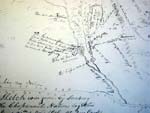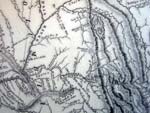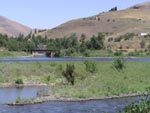|
Journal Entry
On May 6th, 1806, near the confluence of the Potlatch and Clearwater rivers, William Clark wrote these words in his journal:
"at this place we met with three men of a nation called Skeets-so-mish [Schitsu'umsh] who reside at the falls of a large river dis[c]harging itself into the Columbia on it's East side to the North of the entrance of Clark's [Fork] river. this river they informed us headed in a large lake [Coeur d'Alene] in the mountains and that the falls below which they reside was at no great distance from the lake. these people are the same in their dress and appearance with the Chopunnish [Nez Perce], tho' their language is entirely different, a circumstance which I did not learn untill we were about to set out and it was then too late to take a Vocabulary." (Thwaites 1904-05 (4):363).
LinksTo gain additional background on the Euro-American historical context of the Lewis and Clark era, consider visiting the:
Monticello module and the
Philadelphia module within this site.
Maps
 | | Lewis and Clark's map of the Ske(e)t-so-mish country and Waytom Lake, ca. 1806 |
 | | Lewis and Clark's map of the Ske(e)t-so-mish country and Wayton(m) Lake, ca. 1814 |
To view additional historic and contemporary maps, go to:
Schitsu'umsh and Coeur d'Alene Maps
|
|
 | | Confluence of the Potlatch and Clearwater rivers, August 2002 |
Upon their return trip from the Pacific coast, near the confluence of the Clearwater and Potlatch rivers, Meriwether Lewis and William Clark and the Corps of Discovery camped with the Nimíipuu. Not unlike any other day, there were other visitors in camp as well. On this day, May 6th, 1806, William Clark and three Schitsu'umsh first set eyes upon each other. Based upon the resulting exchanges, the journal entries of Lewis and Clark record some 120 Skeet-so-mish lodges with "Probable No. of Souls" of 2000 (Thwaites 1904-05 (6):119). Also referred to was "Waytom Lake" (Lake Coeur d'Alene) which is "10 days around it, has 2 Islands and is 7 days from the Chopunnish" (Thwaites 1904-05 (5):94).
|
Listen as Felix Aripa, tribal elder, talks about the location where Lewis and Clark met three Schitsu'umsh in May of 1806. It is one of many places the Nez Perce showed the Schitsu'umsh where to fish for salmon along the Clearwater River. (recorded and edited by Rodney Frey in August 2002)
|
While a couple of Schitsu'umsh families have kept the knowledge of this meeting alive for generations within their family's oral histories, for most Schitsu'usmh of 1806 the actual encounter was of little immediate concern. There is no recollection of a great council of elders held to discuss the event. Like so many other tribes along the Lewis and Clark trail, knowledge of the "strange people" from the east and their coming west was well known and anticipated long before their actual arrival. As long as the suyepmsh (white people; swiywiyepmsh
refers to the plural form; sometimes hear: suuyapi) respected the ways of the Schitsu'usmh there would be no need for alarm.
|
Felix Aripa considers some of the eventual consequences resulting from the "discoveries" of Lewis and Clark, from the introduction of "gardening" to "giving up the old ways." (recorded and edited by Rodney Frey in August 2002)
|
Nevertheless, while the encounter was brief, the long term consequences were pervasive and would continue to reverberate in the lives of the Schitsu'umsh. The lands of the Skeet-so-mish would soon be frequented and inhabited by many more Euro-Americans. A door was opened wide to a new and most challenging chapter in the history of the Schitsu'umsh. An alarm was sounded, but much too late.
We invite you to continue your journey with us as we explore many of the specific consequences resulting from the encounter with the Corps of Discovery and their aftermath, as well as the broader repercussions associated when two very distinct cultural traditions collide.
For example, what are the effects for an indigenous people such as the Schitsu'umsh of having their sovereign rights undermined, or
of being forced to accept an alien religion, or an alien way of determining property and land ownership, or even an alien way of coming to know the world?
We certainly cannot and will not speak for the experiences of other Indian tribes, but our hope is that by addressing some of these larger issues, you will better appreciate the struggles faced, as well as the aspirations dreamed in Indian country today following those fortuitous meetings during 1805 and 1806.
© Coeur d'Alene Tribe 2002
|
|
|
|











